Constant Light Regulation
The Constant Light Regulation is a closed-loop controller regulating the light value of three lamps/lamp groups: a main lamp (group) and two sub lamps/lamp groups. The actual value for calculating the setpoint-deviation is given by an analog sensor (group). An additional motion detector activates/deactivates the control-system automatically. As fast changing light levels are not desired for a light control, the system is dampened by a control delay (dead-time), which becomes shorter, the higher the deviation is. Moreover, a control hysteresis is implemented to prevent the system from swinging around the setpoint value. The value of the hysteresis can be entered in the settings-menu, as well as the Maximum Control Delay. The following two diagrams show the behavior of the regulation. Please note, that the actual light level is influenced by the (outside-) daylight, as well as by the own inside-light. Without being influenced by the own light, the whole regulation would be a simple open-loop controller. However, this is the reason, why the diagrams show the actual level following the control value. The step size is constant and set to 0,39% which is equal to 1 DALI-Step.
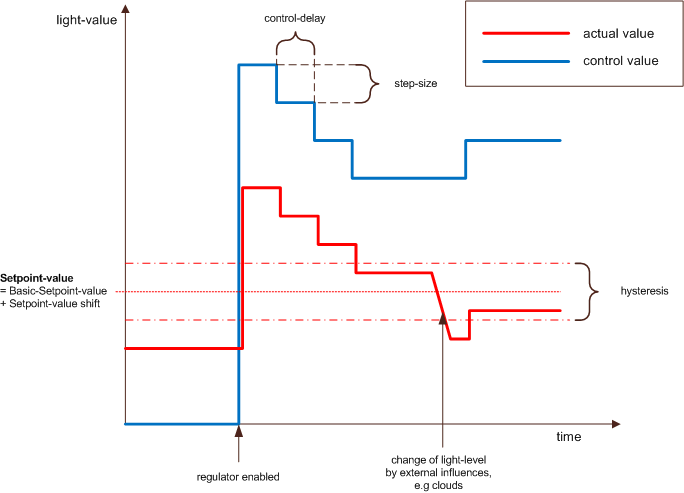
Fig. 1: Hysteresis is big enough to prevent the control-system from oscillating.

Fig. 2: Hysteresis is too small. The system begins to swing around the setpoint value.
Initial Value
Since the functional unit is a closed control loop, the resulting manipulated variable is continuously recalculated and cannot be determined in only one PLC cycle. It is therefore necessary to start with a value close to the resulting output variable.
The decisive factor for this calculation is the ratio of system deviation to setpoint when the control is activated. If this value is greater than or equal to the parameter Factor limit activation control, then the manipulated variable is set to 100%. If the value is less than or equal to the parameter Factor limit activation control, then the value for the manipulated variable is calculated from the resulting linear equation:
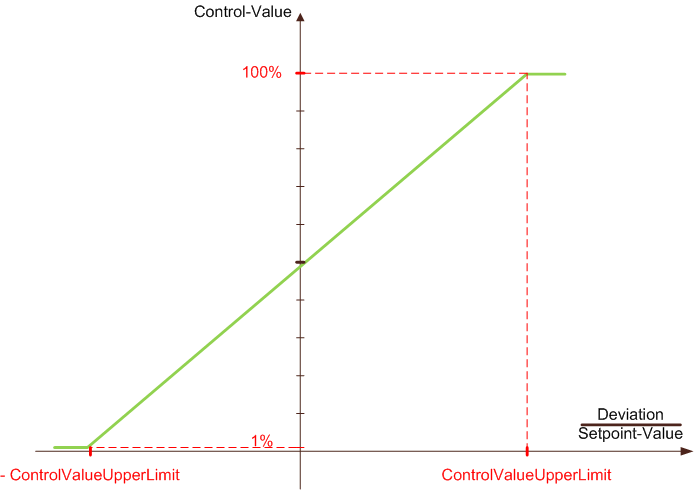
Settings
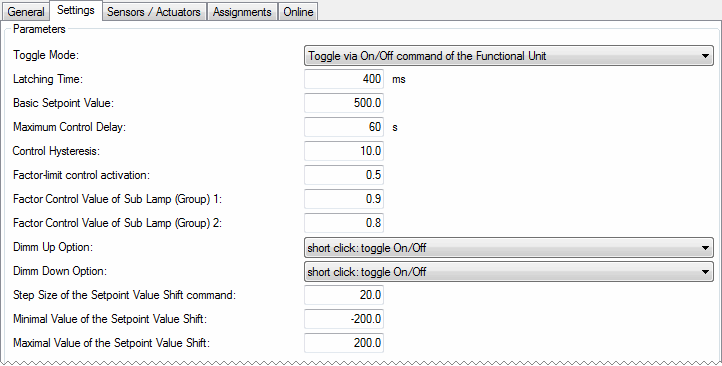
Parameters
- Toggle Mode: If you use the Toggle Mode via "On / Off command of the functional unit", the lamp / lamp group toggles between the resetting value of the functional unit and "off".
If you use the Toggle Mode via "On / Off command of the local value", the lamp / lamp group toggles between the resetting value(s) of the lamp(s) and "off". - Latching Time: Time distinguishing between short and long-click of a pushbutton.
- Basic Setpoint Value: Setpoint value of the Constant Light Regulation. Can be adjusted by an offset, the Setpoint Value Shift, see Online-menu.
- Maximum Control Delay: Maximum delay time before a new control value is taken over. See introduction.
- Control Hysteresis: Hysteresis-band around the setpoint (1/2 hysteresis above and 1/2 hysteresis below). An actual value outside this band will cause the regulation to calculate new control values.
- Control On Upper Limit: See introduction.
- Factor Control Value of Sub Lamp (Group) 1 / Factor Control Value of Sub Lamp (Group) 2: Amplification-factors of the sub lamps/lamp groups relating to the main lamp (group).
- Dimm Up Option: This describes what the assigned lamp (group) will do, if a short-click of Digital Signal (Group) - Dimm Up was detected.
- Dimm Down Option: This describes what the assigned lamp (group) will do, if a short-click of Digital Signal (Group) - Dimm Down was detected.
- Step Size of the Switching Value Shift command: Refers to the Online-menu, where the Switching Value Shift can be increased/decreased by step Up/Down-buttons. This defines the step size.
- Minimal / Maximal Value of the Setpoint Value Shift: The max/min value of Setpoint Value Shift.
Sensors / Actuators
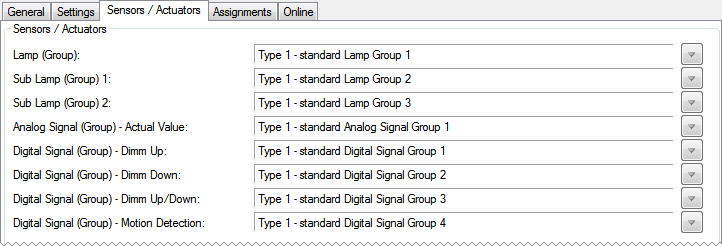
In this menu you enter the lamp / lamp group and the digital signals for switching the correspondent lamp / lamp group.
In general there are two different procedures to control the lamp / lamp group: with two pushbuttons for dimming up and down or with one pushbutton which alternately dims up and down. A combination of both procedures is possible.
Additionally, a Motion Detection can be used to enable the light control: a rising edge at digital signal (group) - Motion Detection enables the Controller, a falling edge disables and switches off the controller.
Dimming up and down during an active control has a special effect: The light value increases or decreases and after 5 seconds without activating a dimming function, the current light value is set as the resulting setpoint (basis setpoint + setpoint shift) so that the control deviation is then 0. Before this new setpoint value is accepted, a small correction to the light value can be noticed. By dimming with a dimming command, it is possible that all lamps/lamp groups are changed by the same value and that a correction for the gain factors must be carried out by the main lamp/lamp group ↔ underlamp/lamp group.
Online
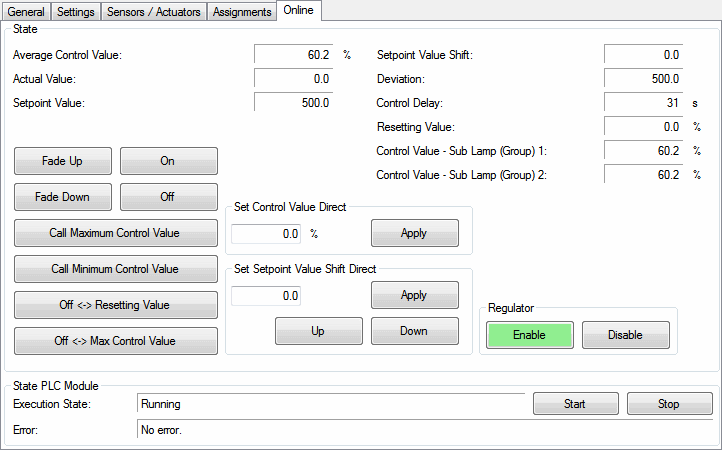
Commands
- Fade Up: This command will increase the light value of all assigned lamps by their entered fade-rate. The command will only work when the lamp is already turned on. Increasing the value above the maximum level is not possible.
- Fade Down: This command decreases the light value by the entered fade-rate but will not let a lamp turn off completely.
- On: Turns the assigned lamps either to the maximum or the Resetting Value, which depends on the fact, if the Resetting Mode is activated or not. The Resetting Mode can be activated for each lamp separately.
- Off: Turns the assigned lamps off. When the Resetting Mode is activated the light value prior to the off state will be stored.
- Call Maximum Control Value: Each lamp will be turned to its maximum level.
- Call Minimum Control Value: Each lamp will be turned to its minimum level.
- Off ↔ Resetting Value: The switching direction depends on the average value of the lamp (group). If the value is greater than 0 all lamps will be turned off. When the value is equal to 0 all lamps will be either turned to their Resetting Value or to their maximum value, when the Resetting Mode is not activated at the lamp.
- Off ↔ Max Control Value: The same as Off ↔ Resetting Value but all lamps will be toggled between off and their maximum value.
- Set Control Value Direct: The entered value will be taken over to the lamps, when the Apply-button is pressed. If the entered value is greater than the maximum value of one of the lamps, the lamp will be set to its maximum level. If it is lower than its minimum level, but not 0, the lamp will be set to its minimum level. Entering and applying a 0 will turn the lamps off.
- Set Setpoint Value Shift Direct: Field to enter the Setpoint Value Shift either directly in a textbox or stepping up and down with the entered step size (see Settings-menu). The value is, however, delimited by the maximum and minimum value in the Settings-menu.
- Regulator Enable/Disable: Sets the twilight-switch in automatic/manual mode. When the PLC is started, the regulator is disabled.
All Input functions are only possible, when the regulator is disabled, except the control Enable/Disable-functions. In addition, it is possible to disable the active control and turn off the lamps with the Off-button. This functionality can be used for e.g., presentations, when a conference room must be dark. The next rising-edge of the motion detector, however, will reactivate the controller, so the delay off-time of the digital signal (group)(motion detection), has to be big enough to ensure secure presence detection over a long time.
State
- Control Value: Average value of the active (non-erroneous) lamp/lamps of of the main group.
- Actual Value: Measured light level.
- Setpoint Value: Actual setpoint value resulting from the Basic Setpoint Value and the Setpoint Value Shift.
- Setpoint Value Shift: Actual setpoint value shift.
- Deviation: The deviation in seconds.
- Control Delay: Displays the control delay in seconds.
- Resetting Value: When the functional unit is turned off, the previous light level will be stored in this variable. If you have selected the entry "Toggle via On/Off command of the Functional Unit" as "Toggle Mode", the lamps in the functional unit are set to this value, when they are switched on with the command Off ↔ Resetting Value and the Resetting Mode of the lamp is deactivated.
- Control Value - Sub Lamp (Group) 1: Average control value of sub lamp (group) 1 in percentage.
- Control Value - Sub Lamp (Group) 2: Average control value of sub lamp (group) 2 in percentage.
State PLC Module
- Execution State: Shows if the module is running or stopped.
- Error: In case of an error, the error code and the error parameter are displayed in this box.
- Start/Stop: Starts/stops the module.